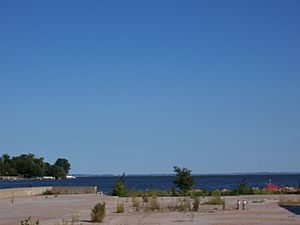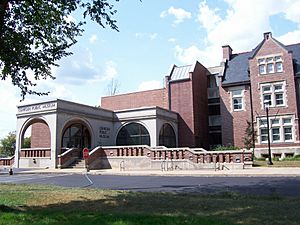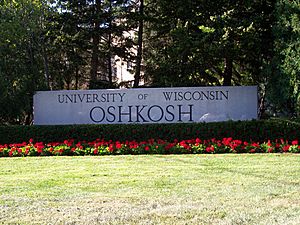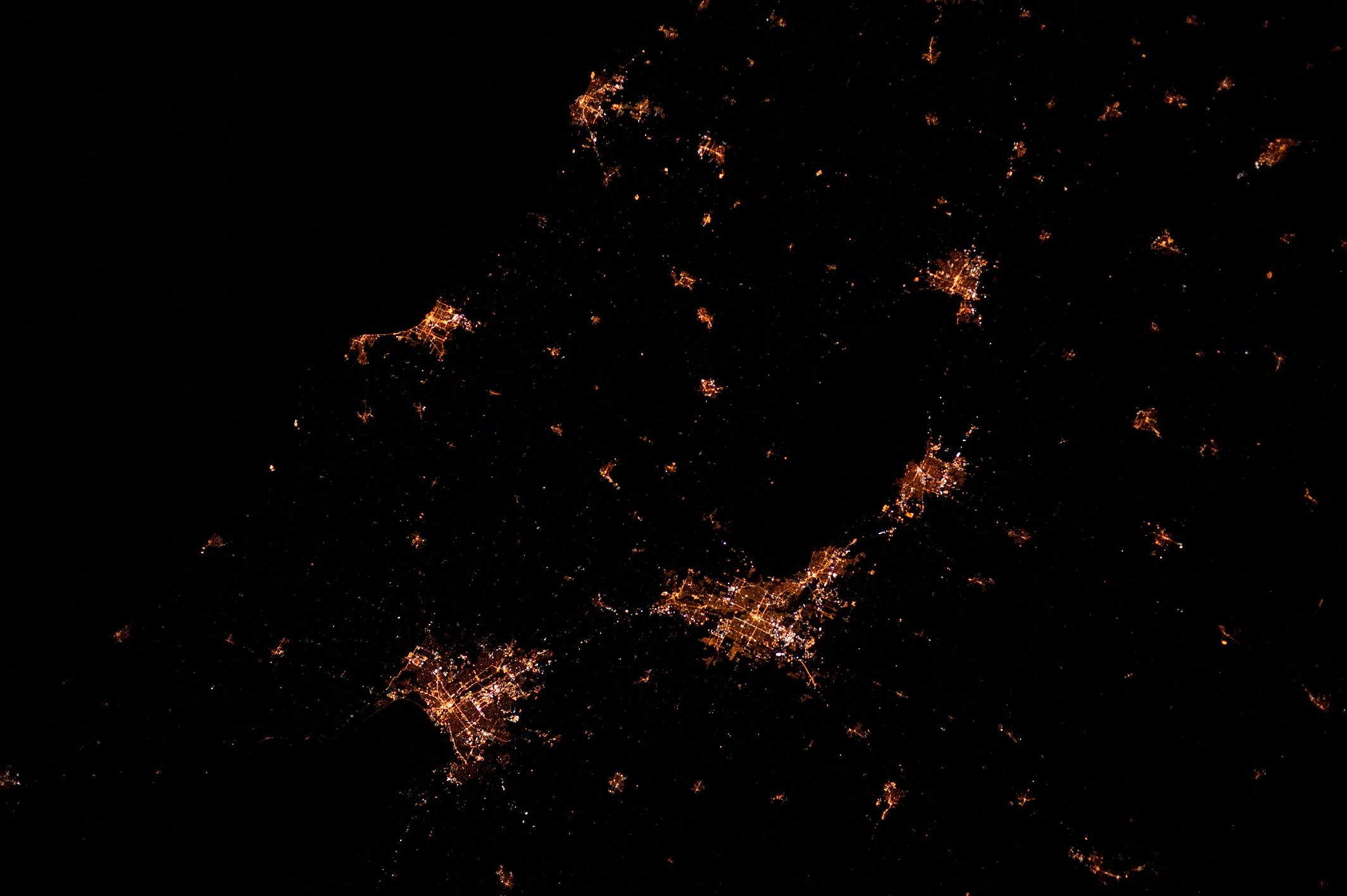Oshkosh, Wisconsin facts for kids
Quick facts for kids
Oshkosh, Wisconsin
|
|
|---|---|
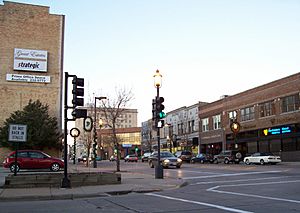
Downtown Oshkosh at U.S. Route 45
|
|
| Nickname(s):
Sawdust City
|
|
| Motto(s):
"On the water"
|
|
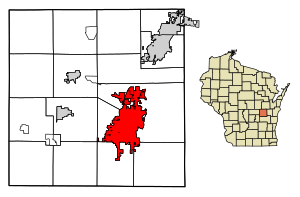
Location of Oshkosh in Winnebago County, Wisconsin.
|
|
| Country | United States |
| State | Wisconsin |
| County | Winnebago |
| Incorporated | April 5, 1853 |
| Government | |
| • Type | Council-Manager |
| Area | |
| • City | 28.03 sq mi (72.60 km2) |
| • Land | 27.02 sq mi (69.98 km2) |
| • Water | 1.01 sq mi (2.61 km2) |
| Elevation | 790 ft (241 m) |
| Population
(2020)
|
|
| • City | 66,816 |
| • Rank | 9th in Wisconsin |
| • Density | 2,472.7/sq mi (954.7/km2) |
| • Metro | 160,000 |
| Time zone | UTC– 06:00 (CST) |
| • Summer (DST) | UTC– 05:00 (CDT) |
| ZIP Codes |
54901–54904
|
| Area code(s) | 920 |
| FIPS code | 55-60500 |
Oshkosh (![]() i/ˈɒʃkɒʃ/) is a city in Wisconsin, United States. It is the main city of Winnebago County. You can find it on the western shore of Lake Winnebago. In 2020, about 66,816 people lived there. This makes it the ninth-largest city in Wisconsin. The area around Oshkosh, including all of Winnebago County, had about 171,730 residents in 2020. It is part of the larger Fox Cities region.
i/ˈɒʃkɒʃ/) is a city in Wisconsin, United States. It is the main city of Winnebago County. You can find it on the western shore of Lake Winnebago. In 2020, about 66,816 people lived there. This makes it the ninth-largest city in Wisconsin. The area around Oshkosh, including all of Winnebago County, had about 171,730 residents in 2020. It is part of the larger Fox Cities region.
Contents
History of Oshkosh
Oshkosh got its name from Menominee Chief Oshkosh. His name meant "claw." The first European settlers came to the area around 1818. They were interested in the fur trade. However, Oshkosh never became a very big center for fur trading.
After 1830, much of the fur trade moved west. This was because there were not as many animals left in the area. In 1832, the Black Hawk War brought more attention to Wisconsin. More white settlers from the East Coast began to move here. By 1836, cities like Milwaukee and Madison were founded. Madison became the capital of the new territory.
The city of Oshkosh grew a lot because of the wood industry. Oshkosh was already chosen as the main city for the county. It officially became a city in 1853. At that time, nearly 2,800 people lived there.
Lumber Industry Growth
The lumber industry became very strong in Oshkosh. Businessmen used the rivers to send wood to different markets. They also got wood from the northern pine forests. In 1859, trains arrived. This helped the industry grow even more. Oshkosh became known as the "Sawdust Capital of the World." By 1860, there were 11 lumber mills in the city.
During the American Civil War, a group of soldiers called the 21st Regiment, Wisconsin Infantry, was formed in Oshkosh. They joined the Union Army. This group marched to Ohio and Kentucky. They helped build defenses there.
By 1870, Oshkosh was the third-largest city in Wisconsin. It had more than 12,000 people. Many teachers, lawyers, doctors, and business people moved to the city. They helped it grow and succeed. The Oshkosh Daily Northwestern newspaper started around this time. Also, the Oshkosh State Normal School, now the University of Wisconsin Oshkosh, was founded. Lumber continued to be the most important industry. By 1874, the city had 47 sawmills and 15 shingle mills.
The Great Fire and Beyond
On April 28, 1875, a huge fire, called the "Great Fire," swept through Oshkosh. It destroyed many homes and businesses along Main Street. The fire burned down 70 stores, 40 factories, and 500 homes. The damage cost about $2.5 million, which would be about $67.3 million today.
Around 1900, Oshkosh was home to the Oshkosh Brewing Company. They made a famous beer called Chief Oshkosh. Their slogan was "By Gosh It's Good." By 1910, the city's population was 33,062. This made it the fourth-largest city in the state.
The Oshkosh All-Stars basketball team played in the National Basketball League from 1937 to 1949. This was before the NBA was formed. The team reached the championship finals five times.
Historic Places
Oshkosh has 33 places listed on the National Register of Historic Places. Many people who made money in the lumber industry helped build the community. They supported charities and were involved in local government. After the big fires in the 1870s, many new and beautiful buildings were built. These included homes, shops, government buildings, and churches.
The city's historic areas show how important the lumber industry was. The money and materials from lumber helped build these places. As of 2011, Oshkosh had six historic districts. These include Algoma Boulevard, Irving/Church, North Main Street, and the Oshkosh State Normal School campus. There are also the Paine Lumber Company and Washington Avenue historic districts.
The city also has 27 historic buildings and sites listed on the National Register. These include houses, churches, schools, a bank, a fire house, an observatory, the Winnebago County Courthouse, and a cemetery. Many important business people are buried there.
Geography and Climate
Oshkosh is located at 44°1′29″N 88°33′4″W / 44.02472°N 88.55111°W. The city covers about 26.61 square miles (68.92 square kilometers). Most of this area is land, with about 1.02 square miles (2.64 square kilometers) of water.
Oshkosh is the main city of a larger metropolitan area. This area includes nearby towns like the Town of Oshkosh to the north. It also includes Algoma to the west, Nekimi to the southwest, and Black Wolf to the southeast. All these towns are in Winnebago County.
Local Climate
Oshkosh has a climate with warm summers and cold winters. This is called a humid continental climate. Summer days are usually warm or hot, and nights are cool. Winters are long and cold, with a good amount of snow. The most rain falls from late spring to early autumn.
| Climate data for Oshkosh (1991–2020 normals, extremes 1893–present) | |||||||||||||
|---|---|---|---|---|---|---|---|---|---|---|---|---|---|
| Month | Jan | Feb | Mar | Apr | May | Jun | Jul | Aug | Sep | Oct | Nov | Dec | Year |
| Record high °F (°C) | 57 (14) |
67 (19) |
83 (28) |
91 (33) |
104 (40) |
102 (39) |
107 (42) |
102 (39) |
99 (37) |
90 (32) |
78 (26) |
65 (18) |
107 (42) |
| Mean daily maximum °F (°C) | 26.1 (−3.3) |
29.9 (−1.2) |
41.3 (5.2) |
54.4 (12.4) |
67.3 (19.6) |
77.3 (25.2) |
81.7 (27.6) |
79.8 (26.6) |
72.5 (22.5) |
59.0 (15.0) |
44.2 (6.8) |
31.8 (−0.1) |
55.4 (13.0) |
| Daily mean °F (°C) | 18.1 (−7.7) |
21.4 (−5.9) |
32.4 (0.2) |
45.0 (7.2) |
57.7 (14.3) |
68.0 (20.0) |
72.2 (22.3) |
70.4 (21.3) |
62.6 (17.0) |
49.9 (9.9) |
36.6 (2.6) |
24.7 (−4.1) |
46.6 (8.1) |
| Mean daily minimum °F (°C) | 10.2 (−12.1) |
12.9 (−10.6) |
23.5 (−4.7) |
35.7 (2.1) |
48.0 (8.9) |
58.8 (14.9) |
62.7 (17.1) |
61.0 (16.1) |
52.7 (11.5) |
40.8 (4.9) |
28.9 (−1.7) |
17.5 (−8.1) |
37.7 (3.2) |
| Record low °F (°C) | −32 (−36) |
−34 (−37) |
−24 (−31) |
5 (−15) |
20 (−7) |
28 (−2) |
30 (−1) |
32 (0) |
25 (−4) |
8 (−13) |
−8 (−22) |
−27 (−33) |
−34 (−37) |
| Average precipitation inches (mm) | 1.34 (34) |
1.11 (28) |
1.92 (49) |
3.21 (82) |
3.94 (100) |
4.82 (122) |
3.76 (96) |
3.40 (86) |
3.26 (83) |
2.89 (73) |
2.05 (52) |
1.59 (40) |
33.29 (846) |
| Average snowfall inches (cm) | 9.8 (25) |
10.1 (26) |
5.4 (14) |
1.8 (4.6) |
0.0 (0.0) |
0.0 (0.0) |
0.0 (0.0) |
0.0 (0.0) |
0.0 (0.0) |
0.3 (0.76) |
1.8 (4.6) |
10.0 (25) |
39.2 (100) |
| Average precipitation days (≥ 0.01 in) | 8.9 | 8.1 | 8.6 | 11.4 | 12.1 | 11.4 | 10.2 | 9.8 | 9.3 | 10.4 | 9.0 | 9.3 | 118.5 |
| Average snowy days (≥ 0.1 in) | 6.3 | 5.7 | 3.3 | 1.1 | 0.0 | 0.0 | 0.0 | 0.0 | 0.0 | 0.1 | 1.7 | 5.5 | 23.7 |
| Average ultraviolet index | 1 | 2 | 3 | 5 | 7 | 8 | 8 | 7 | 5 | 3 | 2 | 1 | 4 |
| Source 1: NOAA | |||||||||||||
| Source 2: Weather Atlas (UV index) | |||||||||||||
Population and People
| Historical population | |||
|---|---|---|---|
| Census | Pop. | %± | |
| 1860 | 6,086 | — | |
| 1870 | 12,663 | 108.1% | |
| 1880 | 15,748 | 24.4% | |
| 1890 | 22,836 | 45.0% | |
| 1900 | 28,284 | 23.9% | |
| 1910 | 33,062 | 16.9% | |
| 1920 | 33,162 | 0.3% | |
| 1930 | 40,108 | 20.9% | |
| 1940 | 39,089 | −2.5% | |
| 1950 | 41,084 | 5.1% | |
| 1960 | 45,110 | 9.8% | |
| 1970 | 53,082 | 17.7% | |
| 1980 | 49,620 | −6.5% | |
| 1990 | 55,006 | 10.9% | |
| 2000 | 62,916 | 14.4% | |
| 2010 | 66,083 | 5.0% | |
| 2020 | 66,816 | 1.1% | |
| U.S. Census Bureau | |||
In 2020, Oshkosh had a population of 66,816 people. Most people in the city were White (83.0%). Other groups included Black or African American (5.3%), Asian (4.4%), and Native American (0.8%). About 5.0% of people were from two or more races. About 4.4% of the population was Hispanic or Latino.
The average income for a family in the city was about $70,534. For individuals, the average income was about $25,625. Most adults (91.3%) had finished high school or higher education. About 26.4% had a bachelor's degree or more.
Diverse Communities
Oshkosh is known for its large population of people with German heritage. About 45% of the people in Oshkosh are German American. In 2022, there were about 28,253 German Americans living in the city.
Like many other cities in Wisconsin, Oshkosh has welcomed many Hmong refugees. In 2022, there were about 2,165 Hmong people living in Oshkosh. They make up about two-thirds of the city's Asian population.
Economy and Jobs
Oshkosh Corporation has its main office in Oshkosh. This company makes special vehicles and parts for different uses. These include vehicles for access equipment, defense, fire and emergency services, and commercial use. Plastic packaging is another big industry here. Amcor, which used to be called Bemis, is a major employer in this field. Oshkosh also has two well-known chocolate companies: Hughes and Oaks.
Oshkosh is also famous for OshKosh B'gosh. This company makes overalls and children's clothing. It started in the city in 1895. At first, it made work clothes for adults. But it became very popular for its children's clothes. The first children's overalls were made so kids could dress like their dads. Sales grew a lot when a company called Miles Kimball, based in Oshkosh, showed the overalls in its catalog. After that, OshKosh B'Gosh started selling its products in department stores. They also made more children's clothing. Now, their main office is in Atlanta, Georgia.
Aviation and Tourism
Oshkosh is home to EAA AirVenture Oshkosh. This event is called "The World's Greatest Aviation Celebration." It is held by the Experimental Aircraft Association, Inc. ("EAA"). AirVenture is the biggest airshow in the world. During this event, Wittman Regional Airport becomes the busiest airport in the world. More than 500,000 people and 10,000 airplanes come to AirVenture each year. The EAA is a group that helps people who build their own airplanes. They also help people who restore old airplanes. The EAA encourages kids aged 8–18 to learn about flying through its Young Eagles program.
Tourism and events are also important to the local economy. People enjoy recreational fishing and boating on Lake Winnebago. There are many fishing tournaments and boat races. Music festivals are also popular. These include the summer-long WaterFest downtown. There are also big summer music festivals for country, Christian, and rock music. In December, there is a drive-through lights show that many visitors enjoy.
Oshkosh also has two regional hospitals. The Winnebago Mental Health Institute is located nearby in Winnebago, Wisconsin.
Arts and Fun Things to Do
A plan to improve downtown Oshkosh led to the building of the outdoor Leach Amphitheater. It is located on the Fox River. This place hosts the weekly Waterfest concert series in the summer. It also has national music acts and local community events. The Grand Opera House is also downtown. It is a place for live shows. Downtown Oshkosh also has a farmers market on Saturdays during the summer.
The Downtown Oshkosh Gallery Walk happens every first Saturday of the month. It is a popular event where people can see art. Many music places have opened downtown. They have more shows now. The Jambalaya Art Cooperative and Art Space Collective are important art spots. In 2010, Chicago Magazine said The Jambalaya Cooperative was a "must see" place in Oshkosh.
Menominee Park is home to the Menominee Park Zoo. A long-running community festival called Sawdust Days used to be held there.
From 1999 to 2019, the International Pathfinder Camporee was held in Oshkosh. This event was hosted by the Seventh-day Adventist church. Tens of thousands of young people and adults from all over the world gathered every five years. The 2019 Camporee had over 56,000 Pathfinders. It was the biggest Adventist youth event ever. A main part of the camporees was the evening shows. These shows acted out stories from the Bible. The events were held near the EAA Aviation Museum. Some of the airplane hangars were changed to make room for booths. In 2021, it was announced that the next Camporee would be in Gillette, Wyoming, in 2024.
Sports and Attractions
The Milwaukee Bucks NBA basketball team has a development team called the Wisconsin Herd. This team started playing in Oshkosh in the 2017–2018 season. They play basketball at Oshkosh Arena.
Other interesting places to visit in Oshkosh include:
- EAA Aviation Museum
- Military Veterans Museum
- Oshkosh Airshow
- Grand Opera House
- Oshkosh Public Museum
- Paine Art Center and Gardens
- Oshkosh Public Library
- University of Wisconsin–Oshkosh
- The southern end of the Wiouwash State Trail.
Education in Oshkosh
The Oshkosh Area School District runs 14 public elementary schools, five public middle schools, and two high schools in Oshkosh. The high schools are Oshkosh North High School and Oshkosh West High School.
Lourdes High School is one of the private schools in the city.
The University of Wisconsin–Oshkosh is located in Oshkosh. It is the third-largest university in Wisconsin. About 15,000 students attend the downtown campus. The university also employs 1,700 staff members. Higher education is also available at a campus of the Fox Valley Technical College.
Getting Around Oshkosh
Main Roads
| Interstate 41 goes north to Appleton and Green Bay. Going south, I-41 leads to Fond du Lac and Milwaukee. It has six exits in the Oshkosh area. | |
| U.S. Route 41 is the same road as Interstate 41 in Oshkosh. | |
| WIS 21 goes west to towns like Omro and Wautoma. | |
| WIS 26 goes south to places like Waupun and Janesville, Wisconsin. | |
| WIS 44 goes southwest to Ripon, Wisconsin. | |
| U.S. Route 45 goes north to New London, Wisconsin and south to Fond du Lac. | |
| WIS 76 goes north to Shiocton, Wisconsin. | |
| WIS 91 goes west to Berlin, Wisconsin. |
Bus Services
Oshkosh has a bus system called GO Transit. It has nine bus routes that run throughout the city. Buses operate from 6:15 am to 6:45 pm, Monday through Saturday. One route also connects Oshkosh to Neenah, Wisconsin, and the Fox Cities' bus system, Valley Transit. You can also take intercity buses to Green Bay, Madison, and other places. These are provided by companies like Amtrak Thruway and Lamers Bus Lines.
Airport Information
Oshkosh's airport is called Wittman Field, or Wittman Regional Airport (KOSH). It opened in 1927. The airport had commercial flights starting in 1928. In 1972, it was renamed after a pilot named Steve Wittman. He was the airport manager for 38 years.
Wittman Field had commercial flights from many airlines until 2003. Now, the closest airport with regular commercial flights is Appleton International Airport in Appleton, Wisconsin.
Wittman Field still hosts the EAA AirVenture Air Show and Expo. This event used to be called the EAA Annual Convention and Fly-In. The EAA started in 1953 in Milwaukee, Wisconsin. The event moved to Oshkosh in 1969 because it had grown too big. During the Airshow, Wittman Regional Airport becomes the busiest airport in the world.
Famous People from Oshkosh
See also
 In Spanish: Oshkosh (Wisconsin) para niños
In Spanish: Oshkosh (Wisconsin) para niños




